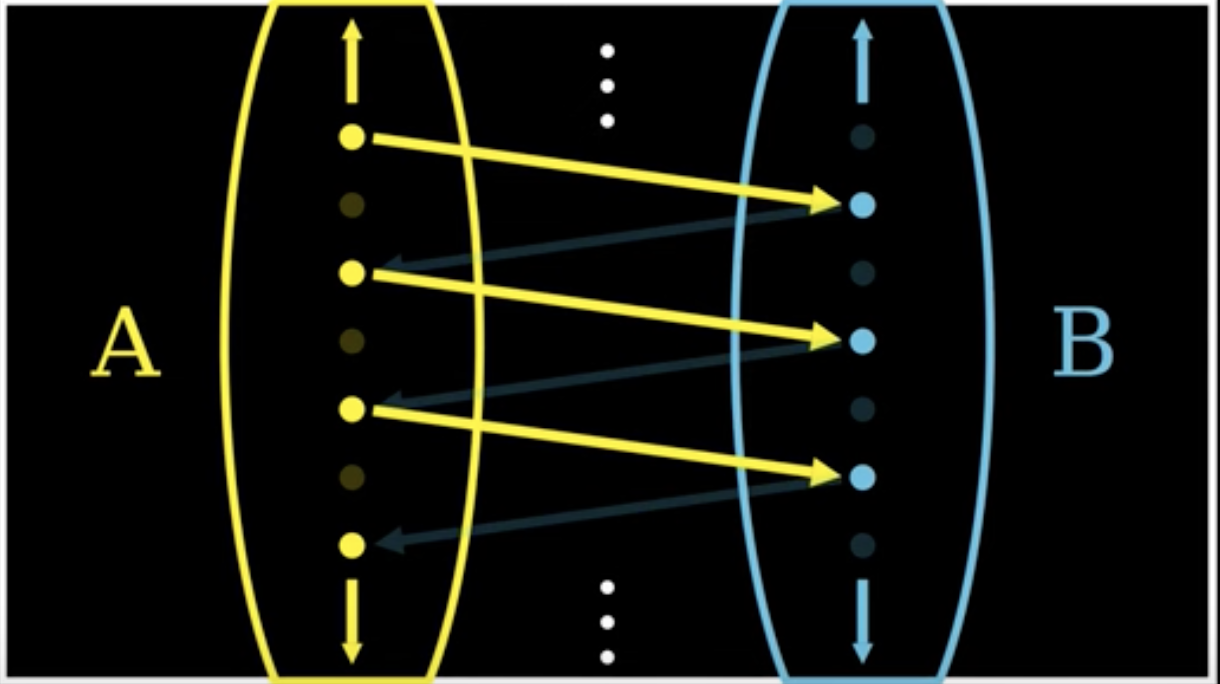Sets
Cantor diagonalization: Reals are not countable.
Sets and are said to have the same cardinality if there exists a bijection between them.
Cardinal arithmetic
Let and . and are called cardinal numbers.
Assume and are disjoint.
Defining cardinal arithmetic
- .
- .
- .
Things to verify
- .
- Let , , .
- .
- .
- we need to supply a bijection between the two sets, which is just the identity map.
-
-
- We need to construct a bijection .
- define to be where .
- is a set of functions which take in an element from and give a function which maps from to . Similar to how currying works in functional programming languages.
-
- We need a bijection between and .
- Define such that , where and are the restrictions of to and respectively.
Comparing cardinalities
For two sets and , we say that if there is an injective map (or, equivalently, if there exists a surjective map ).
Theorem 1(Lemma).
Let , . There exists an injection from to iff there exists a surjection from to .
Proof of
, injective.
Want , surjective.for some .
Proof of
, surjective.. (This requires the axiom of choice)
if there exists an injection from to but no bijection. (requires AOC)
Schröder–Bernstein theorem
Theorem 2(Schroder-Bernstein Theorem).
If is an injection and is a injection, then .
Makes proving things like easy.
Proof 1
Assume and are disjoint so the notation does not become too cumbersome.
Consider the set of all sequences . If does not have a preimage under , the sequence starts at (Note the set of sequences obtained by and interchanging and is equal to ). So, every element appears in one (and exactly one) sequence in . The a sequence in can be characterized like so:
- Starts at : Has a first element in which does not have a preimage under . Denoted by .
- Starts at : Has a first element in which does not have a preimage under . Denoted by .
- Loops forever: Continues forever in both directions, but the elements loop.
- Continues forever in both directions, but does not loop.
Note that sequences in and are incapable of looping. Thus, , , , and actually form a partition of .
Now, if , note that is surjective when its domain is restricted to and codomain is restricted to . Similarly, if , is surjective when its domain is restricted to and codomain is restricted to (or, equivalently, is surjective with its domain restricted to and codomain restricted to ). Note that since these functions were already known to be injective, surjectivity makes them bijective.
Finally, note that both and are bijective for sequences in and , when their domains and codomains are restricted appropriately.
Thus, it makes sense to construct a function :
It is easy to see that is a bijection. ◻️
Proof 2 (Done is class, essentially the same idea as the previous one)
For each , the parent of is , if it exists. Ditto for each .
For each , we get a sequence ending at or going off to infinity, where is the parent of . Now, the chain can be of
- infinite length (in which case we say ),
- even length(length = ), or ends at (),
- odd length, or ends at ().
So, we get a partition .
Ditto for .Note that maps to , and maps to . Also note that the restrictions of and to and respectively (with their codomains restricted to and respectively) are surjective. Hence, these restrictions are bijective.
Also note that and map bijectively between and .Define by
is a bijection.
We can use the SBT to prove : just interweave decimal representations for the injection from the cube to the line.
is it possible to define a continuous injective map from the cube to the line?
Theorem 3.
For all either , , or .
References:



